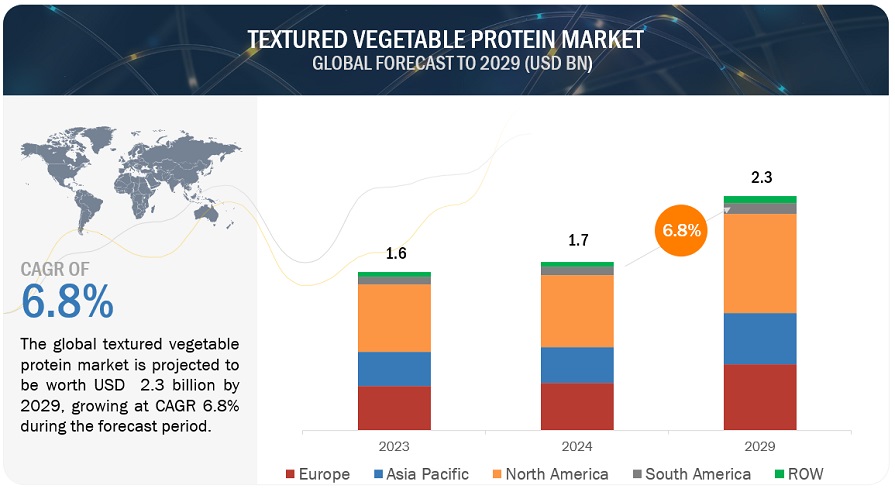Thetextured vegetable protein marketis projected to reach USD 1.9 billion by 2027, recording a CAGR of 6.9% during the forecast period. It is estimated to be valued at USD 1.4 billion in 2022. A considerable percentage of the population in western countries has shifted toward a diet with reduced meat consumption, demanding healthy and tasteful meat-free food products. Due to changes in consumption patterns among consumers, food manufacturers are emphasizing vegetable proteins, such as pulses, wheat gluten, and soy protein, which are processed into meat-like products known as meat analogues. These products mimic certain aesthetic qualities, such as texture, flavor, color, and nutritional characteristics, of specific types of meat.

Download PDF Brochure:https://www.marketsandmarkets.com/pdfdownloadNew.asp?id=264440297
Drivers: Innovations and developments related to vegetable protein augmenting vegan trend
According to The Food Science and Health Database Organization, in 2018, 22 million UK citizens now identify as being a flexitarian, viewed not as a fad diet, but a permanent lifestyle choice, notably most popular among highly influential millennials. Thus, the increasing vegan and flexitarian population is expected to drive the textured vegetable protein market during the forecast period. Increased soy and wheat crop cultivation in developing regions, such as South America and Asia Pacific, has augmented the widespread cultivation of soybean and wheat grains across the globe, resulting in the availability of soy and wheat products, such as textured vegetable proteins.
Healthy Snacking Habits Driving Paradigm Shift In Consumer Behavior For Textured Proteins
Cereals and snacks represent a growing portion of the textured protein market. The growing demand for plant-based foods and vegan alternatives has led manufacturers to use textured proteins in additional application areas, such as cereals and snacks. The use of textured protein granules and flakes allows for their integration into cereals and snack products and improves their mainstream adoption among consumers. The role of textured protein in cereals and snack products has grown substantially, as they were earlier utilized as a means to improve the texture of the final product. However, with the development of new sources, including wheat and pea, the use of textured proteins has witnessed substantial growth. The current line of snack products includes faux meat products, such as vegan jerky, which is manufactured using textured soy or pea, packaged crisps, and even canned foods. Textured proteins in cereals utilize flavored flakes added to products to improve their flavor and nutritional content.
Request Sample Pages:https://www.marketsandmarkets.com/requestsampleNew.asp?id=264440297
Health Benefits Associated With Organic Textured Vegetable Protein Is Driving The Growth
Hydrated, textured vegetable protein delivers a fibrous meat-like texture with outstanding moisture retention, making it perfect for meat and meat alternative applications. Its dry form provides unique textures that characterize many of the most popular bars and snacks. The growing awareness of consumers about the availability of low-cost organic protein is a key element in the organic textured vegetable protein market. Different technologies, such as cell disruption, solubilization/precipitation, and enrichment systems, are used to obtain the protein fraction from organic soy/pea/wheat. The presence of magnesium in the organic textured wheat protein makes it beneficial for health. Magnesium helps improve the body's insulin response by drastically lowering insulin resistance. In this way, the magnesium in the organic wheat flour and zinc helps regulate blood sugar and prevent diabetes.
The key players in this market include ADM (US), Roquette Frres (France), Ingredion (US), DuPont (US), The Scoular Company (US), Beneo (Germany), Cargill, Incorporated (US), MGP (US), Shandong Yuxin Biotechnology Co. Ltd. (China), Axiom Foods, Inc., (US), Foodchem International Corporation (China), PURIS (US), Kansas Protein Foods (US), and DSM (Netherlands).
























